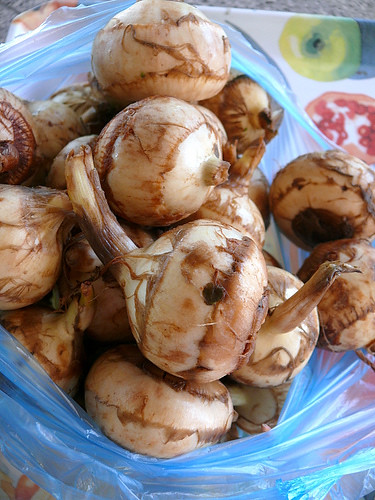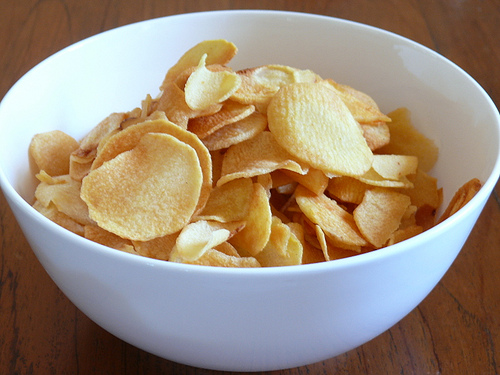
Chi gu are little bulbs that appear in our markets around CNY. Imported from China, chi gu disappear soon after CNY so now is the best time to get your fill of these delicious bulbs.
Chi gu remind me of my dad. He would grow the chi gu in pebbles and water about one month before CNY so that he'll get a pot of bright green leaves which are a symbol of spring, the season when CNY is celebrated. Dad liked to stir-fry chi gu with 'waxed' duck and 'waxed' pork, a dish I didn't like. As a child, I couldn't taste the subtle sweetness of the bulbs and didn't appreciate seasonal produce, especially those from China.

Chi gu chips--yummy!
In recent years, a new way to cook chi gu has made the bulbs popular, especially before CNY. If you haven't eaten chi gu chips, you wouldn't know what I mean when I tell you that they are even tastier than potato chips. Chi gu chips are so addictive that I ate a whole bottle (that's how they are kept, to keep them crispy) last night when watching Hachiko.
My friend Yo told me that chi gu are good fried with pork and nam yue ('Chinese cheese') and I quickly grabbed half a kilo of the bulbs last week because I know they will be off-season soon. I made the mistake of cutting the chi gu too chunky. When cooked for too long, chi gu turn starchy and potato-like, which is not desirable. Chi gu should be sliced thin and stir-fried quickly so that they remain sweet and crispy. Other than that, the dish tasted good as nam yue never fails to enrich the taste and flavor of any dish.
Why do I call chi gu "chi gu" and not arrowroot as most people do? I just found out that chi gu is not arrowroot! Arrowroot (fen ge) is that big taro-like tuber from China which is used to cook soup. What a confused bunch we Malaysians are, calling lei cha "thunder tea", la ya "waxed duck" and chi gu "arrowroot".

Chi Gu N Pork With Nam Yue
500 gm chi gu, peeled and sliced about 1/3 to 1/2 cm thick
500 to 700 gm pork shoulder (belly pork if stewing in bigger chunks), sliced thinly
1 small piece of leek, sliced thinly diagonally
1 T light soy sauce
3 pieces nam yue
1/2 t sugar
1 T cornflour and 3 T water, mixed
optional: sesame oil and oyster sauce
1. Put a tablespoon of oil into a heated wok. Fry the pork until it turns white. Add the chi gu, frying for 1/2 a minute, then add the soy sauce, sugar and nam yue. Stir well to break up the nam yue. Add about 2 to 3 tablespoon of water, stir well. Reduce the heat and cover for 1 minute.
2. Remove the wok lid and fry, sprinkling more water if needed. Add the leeks and fry until they are bright green and cooked through. Add the cornstarch solution to thicken and dish onto a plate. If you add the oyster sauce and sesame oil (I find that the nam yue and soy sauce are good enough), reduce the nam yue by about 1/2 piece.
Serve hot with rice.

5 comments:
Isn't Chi Gu also called Nga Gu?
Dear Terri
I have found out a few years ago tat chi gu is also called ARROW ROOT!
Good info? :P
Shirley
Darn u just said its not!
but my googling leads me to the same pic...
Ahh i found another pic:
http://www.thechinesesouplady.com/arrowroot/
Never really seen it b4!
Shirley
anon: tt's in hokkien or sm other dialect?
shirley: no no arrowroot is 'fen gok' in cantonese!! chi gu look like little white onions but fen gok is like taro. i think it's one of those mix-ups, like taro and yam. you must tell chinese soup lady to do more research on the matter:))
I have heard it's the root of the "arrowhead" plant, in reference to the shape of the leaves - see http://mumusings.blogspot.com/2011/01/snacks-arrowhead-crisps.html
So, it's not arrowroot but arrowhead :-))
Post a Comment